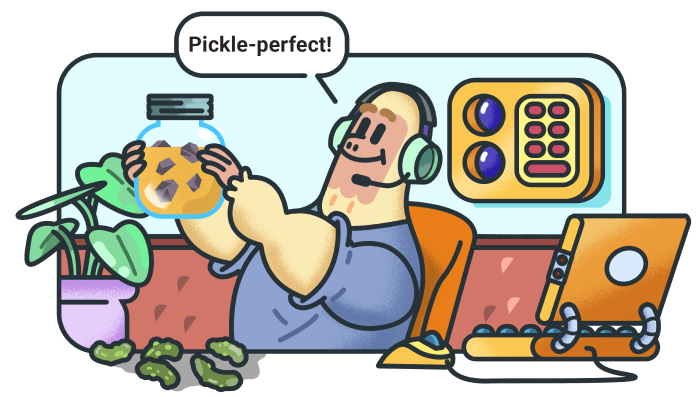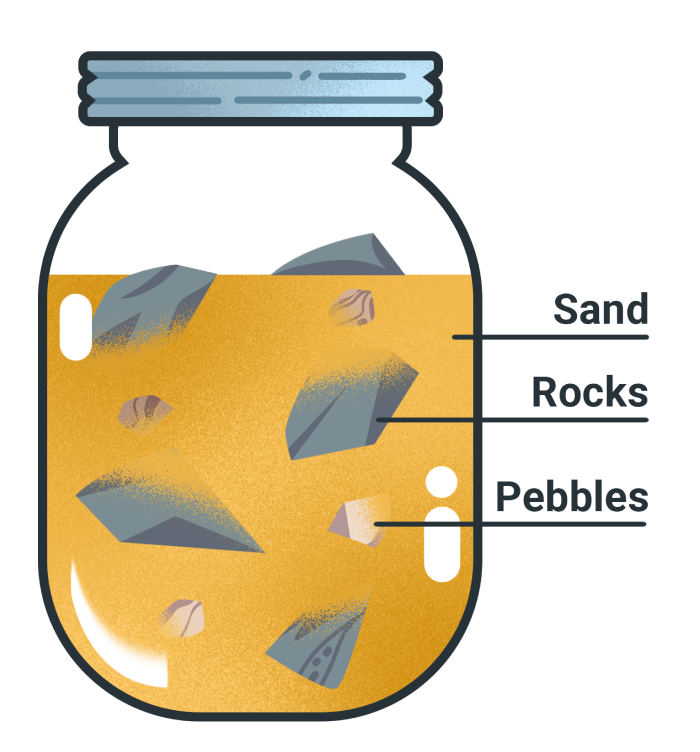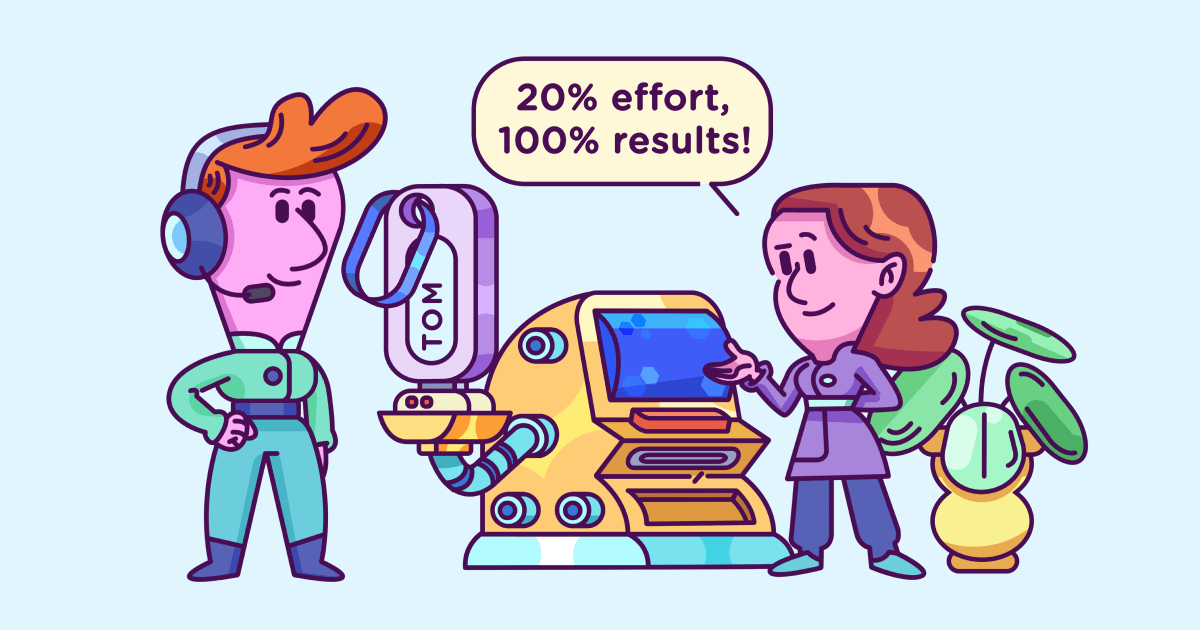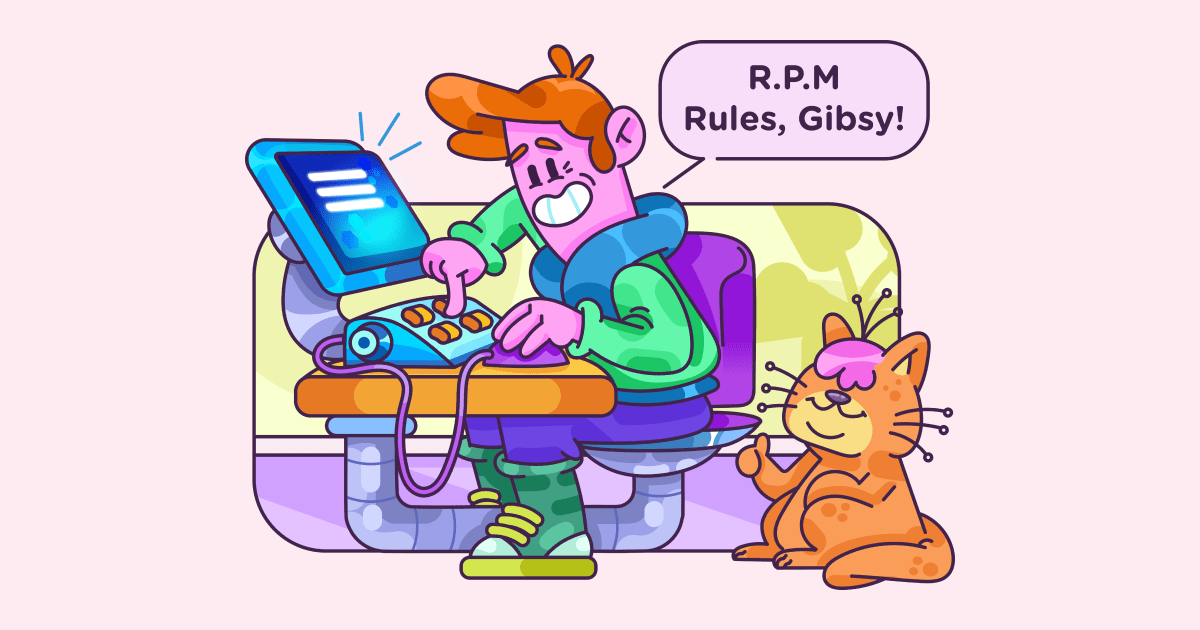The pickle jar theory in time management
Last updated on: May 5, 2023
You are now probably wondering how you ended up reading a text about pickles when you specifically searched for “effective time management techniques”. Don’t worry, you are on the right track. And even if you searched for “how to pickle your vegetables” and wound up here — stay tuned because you are about to find out helpful tips for effective time management.
Do you occasionally feel like you completed countless activities during a working day but don’t seem to be productive at the end of the day? It’s probably because you didn’t prioritize your work accordingly and let insignificant tasks stop you from achieving an ultimate goal. This is where the pickle jar theory comes in. In short, the pickle jar theory is based on prioritizing your daily activities while respecting the time estimate for each.
This blog post will help you understand the gist of the pickle jar theory and how to successfully implement it in your daily routine.

Table of Contents
The pickle jar theory explained
The pickle jar theory is based on a time management technique that prioritizes tasks and responsibilities in a specific order. This theory (also referred to as The bucket of rocks theory or The jar of life theory) was developed in 2002 by Jeremy Wright with the notion that time is a finite space that has limits. In short, the jar of pickles is an analogy where the jar represents our typical day, while the sand, pebbles, and rocks represent everyday activities. What’s more, some sources add another element to the analogy — water, which stands for private life. We can fill the jar with different tasks and activities. But, we need to respect a specific order and time estimate on each activity. Therefore, the pickle jar theory helps us estimate how long a piece of work (either rocks, pebbles, or sand) will take to complete.

To add more details to the bucket of rocks theory, here’s what type of everyday activities the sand, the pebbles, and the rocks represent:
- The sand represents all the small, trivial work such as social networking, chatting with colleagues, mind wandering, and other distractions that kill productivity at work.
- The pebbles symbolize tasks with higher levels of significance than the sand. Those include tasks that can be postponed or delegated to others. They are urgent tasks that can wait, such as phone calls, responding to emails, having meetings. They seem to require an immediate response, but, in fact, are not so important as rocks.
- The rocks signify the most important tasks during a workday. They have a long-term goal and can result in serious consequences if we fail to complete them. For instance, the rocks include actual writing and researching about the topic (for content writers), programming and testing (for software developers), and other crucial tasks that need to be completed to achieve the daily goals.
- Water stands for private life — spending time with family and friends.
The rules for implementing the pickle jar theory
To incorporate the bucket of rocks theory into your life successfully, you must give special attention to the order in which you organize your activities. If you, for instance, fill your jar — i.e., begin your day — with distractions such as chatting with colleagues or social networking and then continue filling your jar with pebbles — i.e., urgent tasks that can wait — you will find your jar almost full in no time. Now, there is no place to put the rocks — the most important activities during the day — in your jar. Thus, your day ends up being unproductive.
To get back on track and make your day more productive, try filling your “jar” with the most important tasks first (up to 4 items).
Then, slowly dose urgent (but not important) tasks.
In the end, deal with distractions.
This way, you will finish your most important tasks first and deal with the rest afterward. You need to bear in mind that highly productive people utilize their resources efficiently and are not obsessed with how much they did but what they did.
However, don’t forget the water, too. In the jar of life theory, water stands for family and private life. These family and private-related activities provide us with a supportive and relaxing environment which is crucial for growth and development in every aspect of life. In the next section of this blog post, we are going to give you an example of a pre-pickle and post-pickle schedule in the workplace.
Implementing the pickle jar theory in real-life (with examples)
Now that we’ve explained the theory and rules for implementing it, let’s provide a real-life example to see how it works in practice. We are about to give an example of an unproductive day and a very productive one relying on the bucket of life theory.
Your schedule prior to the implementation of the pickle jar theory
Before being aware of the importance of time management and implementing the pickle jar theory, your day probably looked something like this (assuming you are a content writer, for example):
| TIME | ACTIVITY |
| 8:00 a.m. | Pebbles: responding to emails and phone calls |
| 8:30 a.m. | Sand: checking social media (because so much has happened since last night) |
| 8:50 a.m. | Sand: coffee break, chatting with colleagues on my way to the cafeteria |
| 9:30 a.m. | Rock number 1: researching about the topic you are writing |
| 11:00 a.m. | Sand: “Let’s make another coffee!” |
| 11:20 a.m. | Pebbles: “My colleague asked me for a favor, I better comply!” |
| 12:15 p.m. | Rock number 2: doing some writing |
| 1:00 p.m. | Lunch |
| 2:00 p.m. | Pebbles: daily meeting, coffee number 3 |
| 3:15 p.m. | Sand: responding to emails and calls — again |
| 3:30 p.m. | Sand: “Let’s see if there’s free shipping for that dress I saw in the store the other day!” |
| 4:00 p.m. | “It’s time to go home!” |
If you consider the number of activities you did for this day — it actually seems like you finished a lot. However, if you take a closer look at what you really did for that day, you will find out that you let distractions (sand) and urgent, unexpected tasks (pebbles) take over your day.
First of all, this was a poor division of your workload. You started your day with minor tasks and distractions, and hence, barely managed to finish two important tasks (rocks) for that day. Moreover, you need to learn how to say “No” if you are already swamped with your work. You can see that you only had 45 minutes at hand to finish an important task (rock number 2).
In short, you tackled numerous tasks but left the most important ones unfinished — which probably left you feeling exhausted at the end of the working day.
Therefore, this day counts as unproductive.
Your schedule after the implementation of the pickle jar theory
If you want to bounce back from an unproductive day and make it count, take a look at how your schedule should look like after you implement the bucket of rocks theory in it (again, assuming you are a content writer):
| TIME | ACTIVITY |
| 8:00 a.m. | Rock number 1: researching for the topic you are writing about |
| 10:30 a.m. | Pebbles: responding to calls and emails |
| 11:00 a.m. | Rock number 2: writing the topic |
| 2:00 p.m. | Pebbles and sand: daily meeting, chatting with colleagues, social networking |
| 3:00 p.m. | Rock number 3: editing the finished blog post |
If you take a look at your schedule with the bucket of rocks theory implemented, you can see that you did fewer but more important tasks. You managed to devote most of your time to the most important tasks (rocks). You made time estimates (e.g., two and a half hours for rock number 1: researching) and left enough time to complete the most important tasks in your schedule — the rocks. Thus, you increased your productivity by eliminating distractions (sand) and answering urgent tasks such as phone calls (pebbles) in a planned and organized manner.
Bear in mind that important things should be tackled first. Then, you can easily squeeze all the shallow work (emails, calls) into your day.
Advantages of the pickle jar theory
Apart from the many advantages that the pickle jar theory can offer us, we’ve selected seven benefits that will immediately persuade you to implement it into your life.
Great way to organize your day
In this article, we already mentioned how doing multiple things doesn’t necessarily lead to success but being frazzled and unproductive. Feeling overwhelmed by your workload is no stranger to working people. Yet, if you develop skills for time management, you will find your days organized and more productive. By integrating the jar of life theory into your daily routine, you take control of your day and have time for your private life, too. This time management technique will help you have a closer insight into important work and time estimates so as to better organize your workday.
💡 If you think the pickle jar theory doesn’t really work for you, check this article out to find your time management style or use a different time management technique to better organize your days → Best time management techniques
Helps you prioritize your tasks
One of the main strengths of the jar of life theory is that it helps us prioritize our tasks more skillfully. When you know that you have one jar and need to fill it with up to four rocks, you need to get into deep thoughts to filter what’s important and what’s not. According to research on the mere urgency effect, people tend to complete urgent tasks over important tasks. Some of the reasons why people cling to urgent tasks are that they seem easier and payoffs happen sooner than with important tasks.
Therefore, in the light of setting bigger goals, one must separate spurious urgency from what’s important to achieve long-term results. For that purpose, you can opt for the jar of life theory to help you visualize a bigger picture and truly understand the importance of your tasks.
Gives you more free time at hand
When you incorporate the jar of life theory into your daily routine, you make time estimates for your workload, thus spending less time on shallow work. This means you will never bring unfinished work home again and expose your family to the tension that arises from working too much. Therefore, effective time management through the jar of life theory helps you spend more time with your family or friends and pursue hobbies, for instance.
Eliminates distractions
According to Cal Newport, the author of “Deep Work: Rules for Focused Success in a Distracted World”, shallow work (pebbles and sand) is inevitable — but, must be kept confined so as to not hinder the performance of your important tasks. Moreover, in his book, he repeatedly emphasizes the importance of uninterrupted, deep work.
One of the main culprits for interruptions at work, he claims, are network tools. They include social media, emails, and text messages.
To prove his claim, he mentions J.K. Rowling and her aversion to social media. She was completely absent from social media at the time when she wrote her “Harry Potter” novels, even though that was merely the era of social media expansion (1997 – 2007). Her staff opened a Twitter account for her in 2009 but it was in 2011 when she wrote:
“This is the real me, but you won’t be hearing from me often I’m afraid, as pen and paper are STILL my priority at the moment.”
Newport also supports his claims by saying how Bill Gates isolates himself by going to the countryside to read and “think big thoughts”.
By following the pickle jar theory guidelines, you make time for your most important tasks and don’t let distractions interfere with your work. So, next time you reach for your phone during work — think about what successful people say about distractions and how eliminating them is the key to productivity and success. We’re not saying you will write the best-selling novel or become the richest person in the world, but it will help you reach your goals and acquire better time management skills.
Helps you overcome procrastination
Good organization and prioritization are some of the most beneficial techniques that can curb procrastination in the workplace. Being organized positively affects setting goals and stops you from making automatic habits that trigger procrastination. The bucket of rocks theory comes in handy due to its meticulous planning nature and triggering strong organizational skills. When you set goals and time estimates for your tasks, your brain receives signals that keep it alert and helps you overcome procrastination.
Prevents multitasking
It’s common knowledge that doing several things simultaneously hinders your performance. Switching from one task to another repeatedly makes you feel overwhelmed and results in decreased performance and diminished quality. This is where the jar of life theory comes to your help since it stops you from multitasking as well. Having a clear insight into your workload and time estimates, you will have fewer chances of multitasking again. It helps you set priorities and focus on one task at a time. Not only will you focus more, but you will avoid making mistakes.
Helps us make time estimates
Among other benefits, the jar of life theory helps us organize our workdays more meticulously by making work-time estimates. When you determine your “rocks of the day”, it’s quite easy to set time estimates for each and stick to them. This is a huge advantage of this theory since it helps you calculate your productive time or gives a report on how you waste your time, for instance.
💡 If you want to become an expert in time estimation, you may find this article useful → How to make precise work time estimates
Time management techniques for implementing the pickle jar theory into your life
There are several ways that you can incorporate the pickle jar theory into your daily routine. We suggest three effective techniques that will help you implement this theory more easily.
Time blocking
Being a parent is exhausting enough, but working long hours and not having time for family can put you in deep water. If you don’t organize your time efficiently, you won’t be able to be with your family and will eventually suffer from burnout. What can come to your rescue is a time management technique called time blocking. It successfully deters procrastination and controls your workload by allocating fixed blocks of time for separate activities. This way you have a clear insight into how much time you spend on each activity.
So, in the case of the pickle jar theory, you can assign a block of time for each rock in your work schedule. For instance, “working on rock number 1” from 9:30 A.M. to 11 A.M., “working on rock number 2” from 11:20 A.M. to 2 P.M., etc. Or you can use this supplementary technique so that you don’t miss important life events such as family gatherings, dance classes, birthday parties, etc.
Therefore, define your “rocks of the day”, set time blocks, and estimates for each. This way you see where your time goes and have control over your workload. For this purpose, you can combine the Pomodoro technique with time blocking to better estimate the time for each activity. This way of managing your time allows you to limit your work time by allocating how much time you want to work, and getting a notification when the timer reaches the allotted time.
The time blocking technique is a good choice for:
- Working parents who have difficulty maintaining a healthy work-life balance,
- Project managers who run several projects simultaneously,
- CEOs and productivity experts (Bill Gates is known for using this technique).
💡 Read a more detailed article about time blocking and try out 9 time blocking planner templates to make sure you leave enough time for your priorities → Time blocking planner (+ 9 free time block templates)
Tracking time
Do you ever pay attention to your screen time notifications? Scary statistics say that according to recorded data from 2019 and 2020, people spend around 2.4 hours a day on social media worldwide. That’s up to 20 hours a week!
Just imagine how much time you waste and all those distractions interfering with your productive work while shifting your attention all the time. It’s about time you start tracking your activities to reduce wastage and boost your productivity.
For that reason, start an experiment and automatically track your activities to monitor which websites and programs you visit most, and how much time you spend on shallow work.
This is where time tracking apps such as Clockify can pitch in to help you have a more detailed evaluation of where your time goes. For example, the auto tracker feature in Clockify will keep track of all active programs you use, websites you visit, and show it in the reports later on. You’ll be able to automatically track your computer activity to better understand how you spend time and how you can best manage it.
Keeping time records is good for everybody and here are some of the benefits of tracking your time:
✅ Better knowledge of how much time you spend on different activities,
✅ Understanding what you are doing wrong and how you can allocate your time better in the future,
✅ Boosting your productivity,
✅ Focusing on important tasks,
✅ Minimizing or completely eliminating distractions.
To-do lists
Using to-do lists is not as easy as it seems. Sometimes we unintentionally make lengthy lists and swamp ourselves with work. Therefore, you can integrate the bucket of rocks theory and follow its guidelines to make effective to-do lists.
When you know your rocks, you can easily form a workable to-do list as well as postpone or delegate some tasks that don’t seem important at the moment.
Not only will you organize your workload better, but never miss an important event in your private life or go grocery shopping again.
To-do lists are a good choice for:
- Working people,
- Teams,
- Students,
- Homemakers.
💡 Whether you are a student, business owner, or just want to make sure you don’t forget to buy milk next time you go grocery shopping, download free to-do list templates and customize them to your needs → Free to-do list templates
Conclusion
We conclude that the jar of life theory is an easy and visually appealing way to better manage one’s time. It’s suitable for everybody — working parents, homemakers, and CEOs, who can gain tangible benefits from the pickle jar theory. Its simple guidelines help us distinguish between important and trivial tasks — hence boosting our productivity. So, find the most suitable time management techniques that can help you incorporate this theory into your daily life — and enjoy the perks of finishing your priorities on time and spending more time with your family or friends.
✉️ What time management technique are you going to use to incorporate the pickle jar theory into your life? Which rocks are you going to tackle first today? Write to us at blogfeedback@clockify.me for a chance to be included in this or one of our future blog posts.





